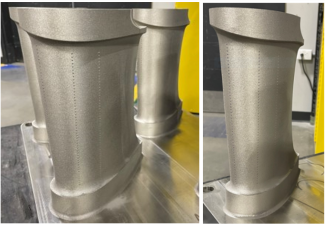GE Vernova’s Gas Power business, under a cooperative agreement with NETL, has successfully tested an advanced cooling architecture enabled by additive manufacturing (AM) to produce turbine components that can deliver improved performance under higher operating pressures and temperatures — crucial factors for increasing turbine efficiency and reducing greenhouse gas emissions from power plants.
To generate electricity, gas turbines burn a mixture of air and fuel, such as natural gas or hydrogen, at high temperatures and pressures. This high-temperature and high-pressure gas is expanded through a series of nozzles and blade-like airfoils, causing the turbine shaft to spin. The spinning shaft, in turn, drives a generator that produces electricity.
Improved turbine efficiency is also necessary to achieve the Biden Administration’s goal of 100% clean electricity, or a net-zero power grid, in the United States by 2035. Needed efficiency gains have been realized by increasing turbine firing temperatures, which are now approaching 3,100 degrees Fahrenheit. However, there’s a downside to burning hotter.
During these processes, hot gas path turbine components, such as blades and vanes, are subjected to an extreme environment that includes high temperatures, high stresses, high vibrations and potential corrosion. All these factors can impact the life of turbine blades and other components. Therefore, these components must be carefully engineered and cooled to withstand these conditions.
Under the agreement with NETL, titled “High-Temperature Additive Architectures for 65% Efficiency,” GE Vernova’s researchers have defined ways to improve the cooling architecture and performance of stationary turbine vanes made using an AM process and compared the cooling effectiveness against vanes produced using current manufacturing processes.
The AM process builds objects by adding material layer by layer, with each successive layer bonding to the preceding layer until the part is complete. This manufacturing process allows researchers to create physical, three-dimensional objects directly from a computer design file.
The AM process can also reduce energy use and can cut waste and materials costs significantly. It is the opposite of subtractive manufacturing, which is the process of starting with solid blocks, bars or rods of a material and shaping them by removing, cutting, boring, drilling and grinding.
According to NETL’s Seth Lawson, federal project manager, GE Vernova’s test campaign was completed ahead of schedule at the GE Research Center in Niskayuna, New York, a facility that simulated the high-temperature conditions in the hot gas path of a utility-scale gas turbine. Results showed that the advanced design made using the AM process and a nickel superalloy met or exceeded cooling effectiveness targets.
“Ultimately, this technology could enable production of AM turbine components that require less cooling flow, leading to improved gas turbine efficiency and thus reduced carbon dioxide emissions,” Lawson said.
Technological strides in turbine development can have wide-reaching economic and environmental benefits. According to data presented at the 2019 American Society of Mechanical Engineers TurboExpo conference, a one-point U.S turbine efficiency improvement, in terms of carbon reduction, is equivalent to eliminating the emissions from 2 million cars.
Lawson said the GE Vernova project, supported with $7.6 million in federal funding, will be completed in late September. Final steps include completing an analysis of the components used in the testing and evaluating data from lab tests of the components.
The project was undertaken as part of the NETL Advanced Turbines Program, which manages a research, development and demonstration portfolio designed to enable a carbon-free electricity sector and to promote environmental justice by developing revolutionary, near-zero-emission advanced turbine technologies.
NETL is a U.S. Department of Energy national laboratory that drives innovation and delivers technological solutions for an environmentally sustainable and prosperous energy future. By its world-class talent and research facilities, NETL is ensuring affordable, abundant and reliable energy that drives a robust economy and national security, while developing technologies to manage carbon across the full life cycle, enabling environmental sustainability for all Americans.




